How To Create A Formula In Excel For A Column
Lesson 6: Creating Simple Formulas
/en/excel2010/saving/content/
Introduction

Excel can be used to calculate numerical information. In this lesson, you will learn how to create simple formulas in Excel to add, subtract, multiply, and divide values in a workbook. You'll also learn the various ways you can use cell references to make working with formulas easier and more efficient.
Simple formulas
A formula is an equation that performs a calculation. Like a calculator, Excel can execute formulas that add, subtract, multiply, and divide.
One of Excel's most useful features is its ability to calculate using a cell address to represent the value in a cell. This is called using a cell reference.
To maximize the capabilities of Excel, it is important to understand how to create simple formulas and use cell references.
Optional: You can download this example for extra practice.
Creating simple formulas
Excel uses standard operators for equations, such as a plus sign for addition (+), minus sign for subtraction (-), asterisk for multiplication (*), forward slash for division (/), and caret (^) for exponents.
The key thing to remember when writing formulas for Excel is that all formulas must begin with an equals sign (=). This is because the cell contains—or is equal to—the formula and its value.

To create a simple formula in Excel:
- Select the cell where the answer will appear (B4, for example).
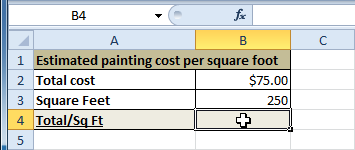 Selecting cell B4
Selecting cell B4 - Type the equals sign (=).
- Type in the formula you want Excel to calculate (75/250, for example).
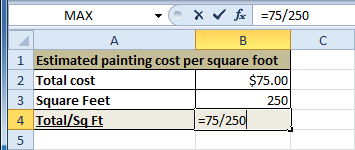 Entering formula in B4
Entering formula in B4 - Press Enter. The formula will be calculated, and the value will be displayed in the cell.
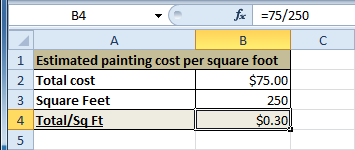 Result in B4
Result in B4
If the result of a formula is too large to be displayed in a cell, it may appear as pound signs (#######) instead of a value. This means the column is not wide enough to display the cell content. Simply increase the column width to show the cell content.
Creating formulas with cell references
When a formula contains a cell address, it is called a cell reference. Creating a formula with cell references is useful because you can update data in your worksheet without having to rewrite the values in the formula.
To create a formula using cell references:
- Select the cell where the answer will appear (B3, for example).
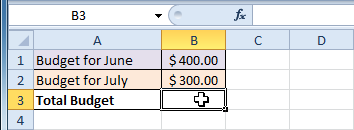 Selecting cell B3
Selecting cell B3 - Type the equals sign (=).
- Type the cell address that contains the first number in the equation (B1, for example).
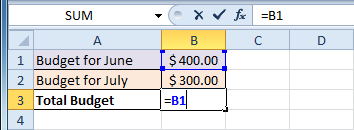 Entering a formula in B3
Entering a formula in B3 - Type the operator you need for your formula. For example, type the addition sign (+).
- Type the cell address that contains the second number in the equation (B2, for example).
 Entering a formula in B3
Entering a formula in B3 - Press Enter. The formula will be calculated, and the value will be displayed in the cell.
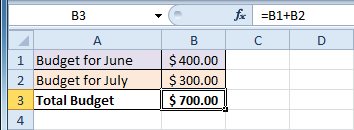 Result in B3
Result in B3
If you change a value in either B1 or B2, the total will automatically recalculate.
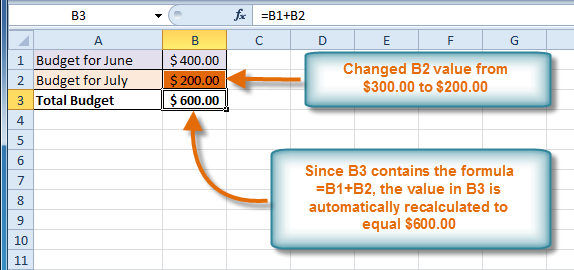 Result in B3
Result in B3
Excel will not always tell you if your formula contains an error, so it's up to you to check all of your formulas. To learn how to do this, you can read the Double-Check Your Formulas lesson from our Excel Formulas tutorial.
To create a formula using the point-and-click method:
- Select the cell where the answer will appear (B4, for example).
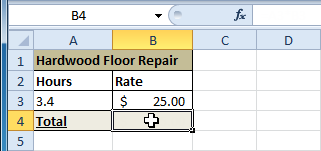 Selecting cell B4
Selecting cell B4 - Type the equals sign (=).
- Click the first cell to be included in the formula (A3, for example).
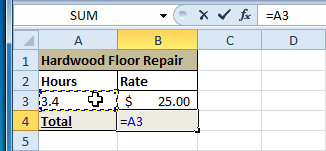 Clicking cell A3
Clicking cell A3 - Type the operator you need for the formula. For example, type the multiplication sign (*).
- Click the next cell in the formula (B3, for example).
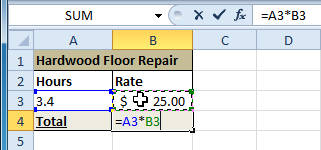 Clicking cell B3
Clicking cell B3 - Press Enter. The formula will be calculated, and the value will be displayed in the cell.
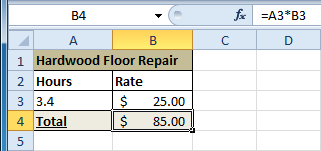 Result in B4
Result in B4
To edit a formula:
- Click the cell you want to edit.
- Insert the cursor in the formula bar, and edit the formula as desired. You can also double-click the cell to view and edit the formula directly from the cell.
- When you're done, press Enter or select the Enter command
 .
.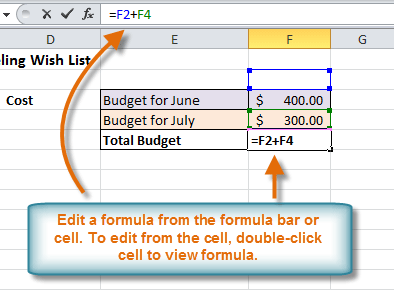 Edit a formula
Edit a formula - The new value will be displayed in the cell.
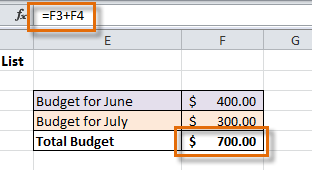 Result
Result
If you change your mind, use the Cancel command  in the formula bar to avoid accidentally making changes to your formula.
in the formula bar to avoid accidentally making changes to your formula.
Challenge!
- Open an existing Excel 2010 workbook. If you want, you can use this example.
- Write a simple division formula. If you are using the example, write the formula in cell B18 to calculate the painting cost per square foot.
- Write a simple addition formula using cell references. If you are using the example, write the formula in cell F5 to calculate the total budget.
- Write a simple subtraction formula using the point-and-click method. If you are using the example, subtract the Expand Bathroom cost (C6) from the Total cost (C11). Calculate your answer in C12.
- Edit a formula using the formula bar.
/en/excel2010/worksheet-basics/content/
How To Create A Formula In Excel For A Column
Source: https://edu.gcfglobal.org/en/excel2010/creating-simple-formulas/1/
Posted by: grossgook1951.blogspot.com

0 Response to "How To Create A Formula In Excel For A Column"
Post a Comment